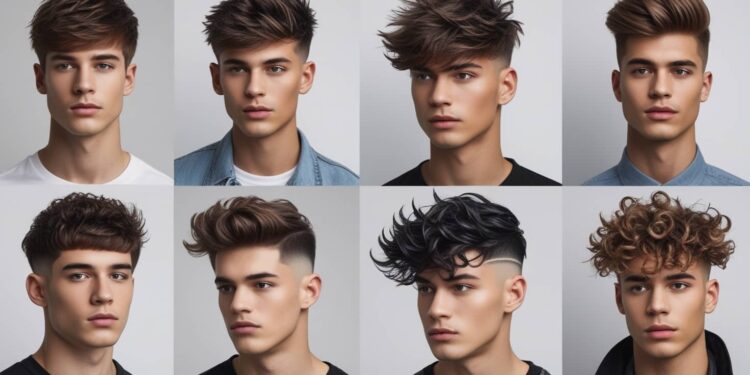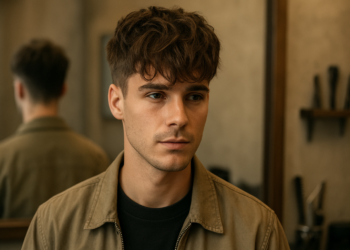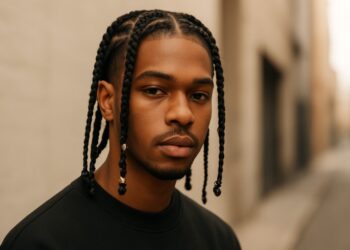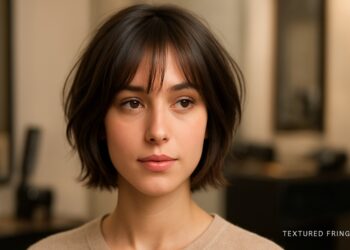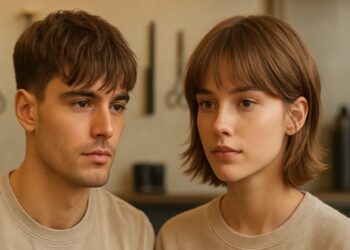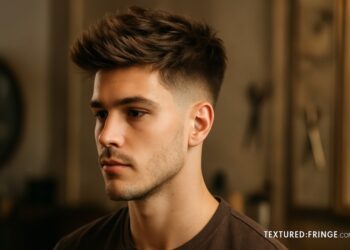Summary: A textured fringe is a cool, modern take on bangs for men – versatile enough for teens, young adults, and even professionals (just adjust length and fade). It flatters most hair types and face shapes, and with the right cut you won’t spend hours styling it. Show your barber a pic of one of the looks above (or describe “choppy layered fringe” with the fade you want) and you’ll walk out with one of these awesome styles.
A textured fringe haircut (a trendy version of bangs for men) is all about layered, choppy ends in the front that give your hair movement and volume. In practice, this means the hair on top is cut into varying lengths so the fringe (or bangs) falls in a casual, tousled way across the forehead. It’s surprisingly low-maintenance – once cut, you can often just towel-dry, add a little texture product, and go. I remember when I first asked my barber for a “textured fringe” (hoping for something edgy but professional); he gave me a neat, layered fringe that softened my square face shape and didn’t need much styling effort. That made me a believer!
Textured fringes are versatile: whether your hair is straight, wavy, or curly, there’s a textured look for you. In fact, a stylist notes that “there’s a textured fringe here that doesn’t just work… It wins,” no matter your face shape or hair type. Generally, oval faces can pull off almost any fringe style, while square or heart-shaped faces often benefit from a softer, feathered fringe to balance sharp angles. Round faces can use a bit of height or a side-swept cut to add dimension. Below are seven popular textured fringe styles to try – each with the hair and face types they suit best. (Pro tip: Bringing a photo of the style to your barber is the easiest way to get exactly what you want.)
What Is a Textured Fringe Haircut?
A textured fringe (often just called “textured bangs”) is a haircut where the front section of the hair is cut into layers and choppy ends, instead of a blunt, straight-across cut. This layering adds depth and dimension, creating a piecey, lived-in look. As one stylist puts it, textured fringe “involves creating layers and texture within the fringe, adding depth and dimension to the overall look.” In other words, instead of a stiff sheet of hair, you get a soft cascade of strands. The result is flattering on many hair lengths and types – from a short crop to longer, tousled locks.
In practice, imagine the barber point-cutting or texturizing the bangs so they naturally sweep or fall forward. Even a very short, cropped fringe with a high fade can be textured, giving a neat but modern finish. On the other hand, a longer fringe might be cut into “feathered” or choppy layers that gently frame the face. Either way, the key is that it never looks too polished or rigid – there’s a casual, effortless vibe to it.
Personal note: I often find textured fringes give a cool confidence boost. You’ll see more of your forehead (which can be good for balancing things), and the cut itself adds softness if you have a strong jawline. Many guys I know say it feels like an “I just woke up like this” style that actually looks intentional and stylish.
Who Should Try a Textured Fringe?
Hair Type:
Straight, wavy, and curly men can rock a textured fringe. For straight hair, the layering adds movement so your bangs don’t just lie flat. Wavy hair works great too (it naturally gives a bit of lift). Even curly-haired guys can wear a textured fringe – just keep it cut slightly longer so the curls don’t shrink too much.
Face Shape:
Almost every face shape can pull off a fringe of some kind. Oval faces are the most flexible (you can try any fringe). Square and heart-shaped faces often benefit from a textured fringe, as the softness of the layers can balance a strong jaw or cheekbones. Round faces might choose a fringe swept to the side or with some height in front to elongate the face.
Lifestyle:
This cut can look neat for work or rebel on the weekend. A classic, well-trimmed textured fringe (with a clean fade) can suit even a professional setting. Conversely, leaving the fringe a bit longer and messier gives a casual, trendy vibe. In short, if you want a haircut that’s adaptable, this is it.
On the practical side, a textured fringe can also help with thinning hair – the choppiness creates the illusion of volume at the front and can cover a receding hairline if cut correctly. So yes, even guys noticing a bit of thinning can consider it. Just ask your barber for light layering at the front and a product to enhance texture, and it can really boost fullness.
7 Textured Fringe Styles to Ask Your Barber For
1. Classic Textured Fringe
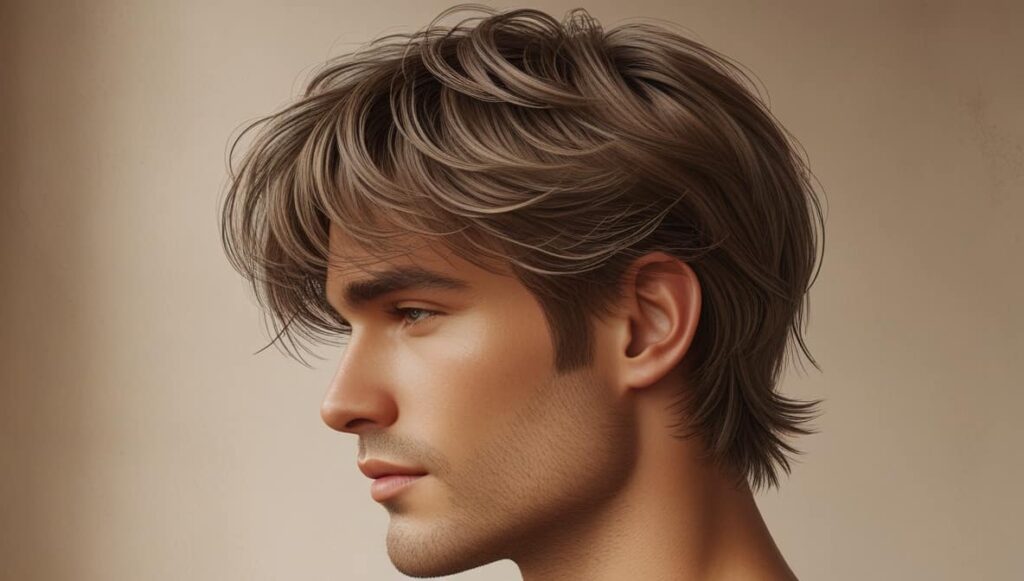
A clean, balanced look with gentle layers. The classic textured fringe features softly layered bangs that fall just above the brows, giving natural flow across the forehead. It’s subtle but modern. This style is usually done with short-to-medium length on top, often paired with tapered or trimmed sides.
- Best for: Straight to slightly wavy hair.
- Face shapes: Oval and square faces (the layering softens edges).
- Why try it? It’s low-effort but polished – you barely need product to keep it in place. Great for guys who want an all-around, always-in-style look.
2. Messy Textured Fringe
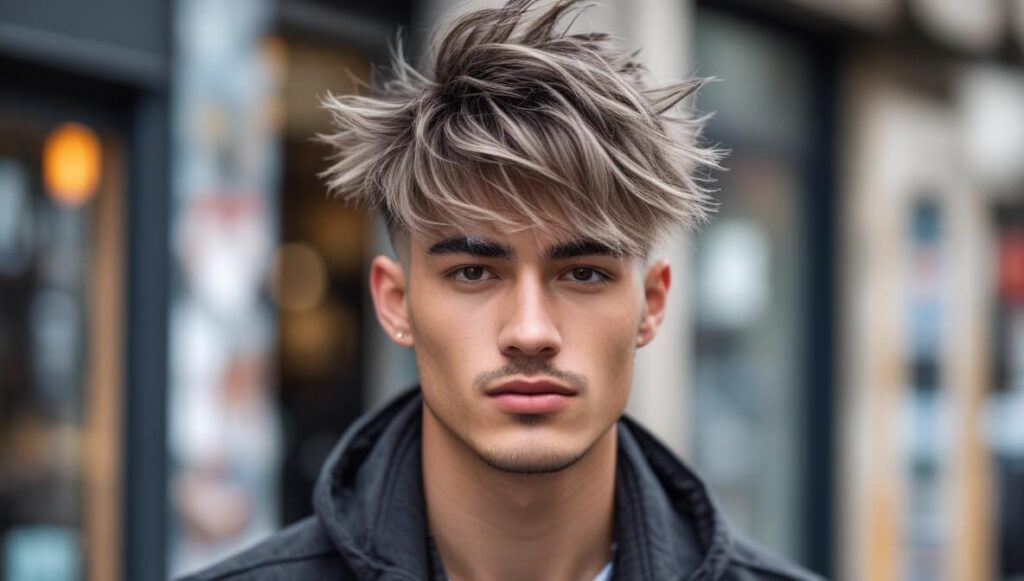
An intentionally tousled, “bedhead” vibe. This fringe is cut with uneven lengths and choppy ends so it looks a bit chaotic on purpose. The hair is styled forward or slightly to the side, creating volume and an edgy feel. It might have a subtle fade or taper on the sides for contrast.
- Best for: Medium to thick hair that holds some volume.
- Face shapes: Round or oval (the extra height and mess can elongate a round face).
- Why try it? If you like that carefree look – “I just rolled out of bed, but still look cool” – this is it. Styling is simple (scrunch with a matte paste) and it shows off texture.
3. Wavy Fringe with Skin Fade
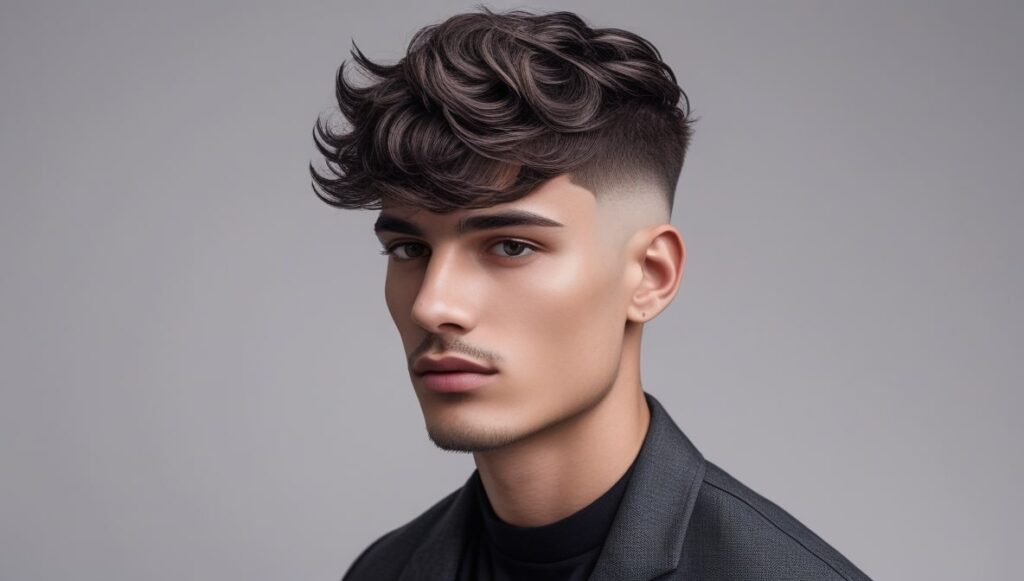
Combine natural waves up top with a clean-shaven fade on the sides. The front fringe is kept medium-length to show off defined waves or loose curls, while the sides are buzzed close for a sharp contrast. It’s an edgy but classy look.
- Best for: Wavy hair (the waves become the star of the show).
- Face shapes: Oval, heart, or diamond faces (the forward movement of hair highlights cheekbones).
- Why try it? The fade makes the style feel modern and neat, while the textured fringe keeps it from looking too stiff. Great for guys who want both polish and personality.
4. High-Fade Textured Fringe
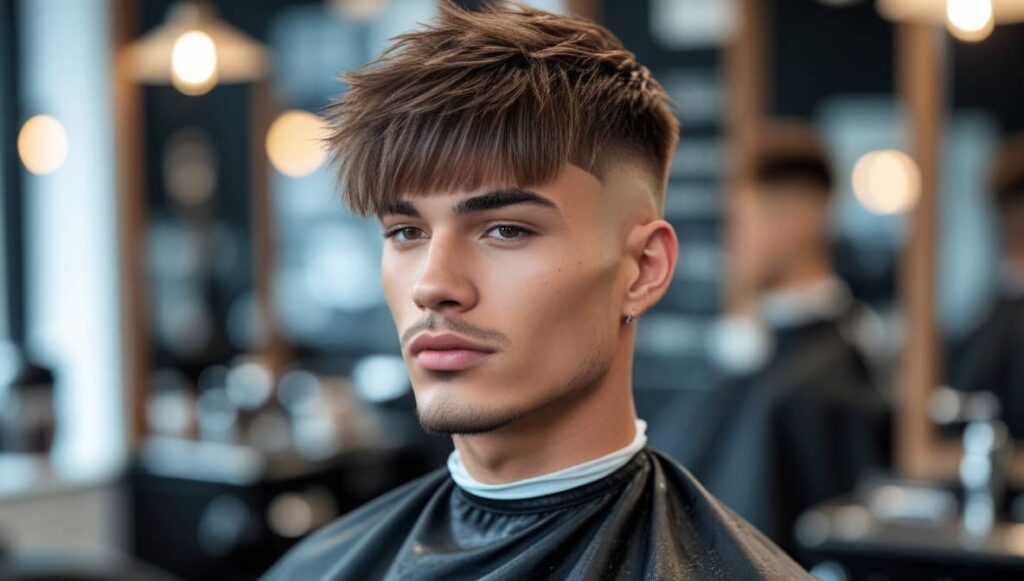
Bold contrast between top and sides. This cut pairs a long, choppy fringe with a very high fade or undercut. The fringe is usually cut forward and maybe slightly to one side, with lots of tiny layers for texture. The high fade (or buzzed sides) makes your forehead area pop.
- Best for: Straight or wavy hair.
- Face shapes: Square and oval (the fade elongates the face; fringe softens a strong jaw).
- Why try it? It’s sharp and modern. The high fade keeps the sides neat for work, but the messy top gives you an edgy weekend look as well. You can sweep the fringe straight forward or push it up for variety.
5. Textured Fringe Crop
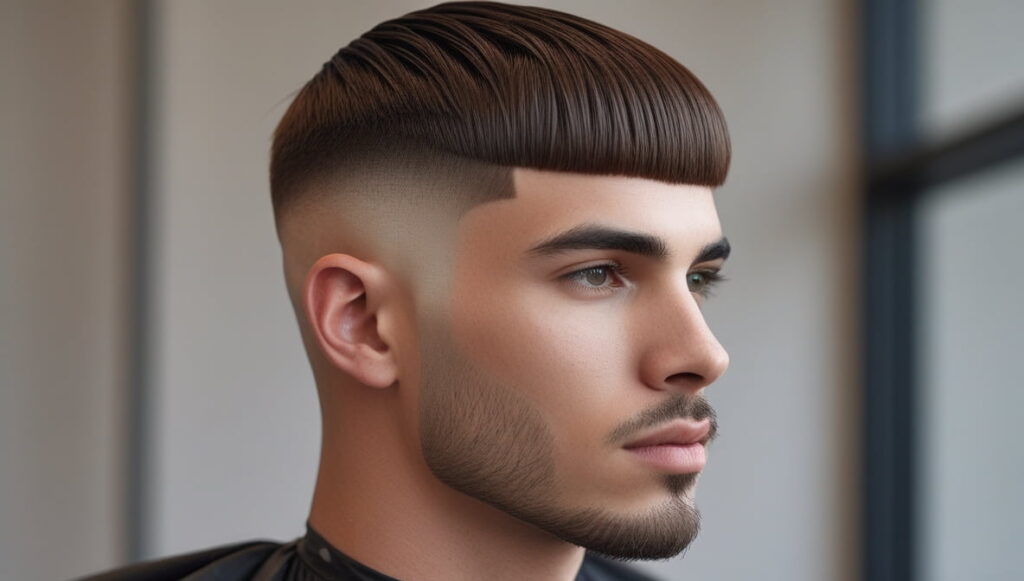
A very short fringe with a uniform, bowl-cut shape but with textured ends. Think of a French crop but with a bit more grit. The bangs are usually cut at brow level with scissors, giving a blunt line, then point-cut for texture. The rest of the hair is kept short (taper or fade).
- Best for: Thick or fine hair that lies flat.
- Face shapes: Oval, rectangular, or triangle (covers the forehead to balance long faces).
- Why try it? It’s neat and super low-maintenance. There’s some edge in the texture, but overall it’s a controlled look. Ideal if you want something sharp yet simple.
6. Curly Textured Fringe
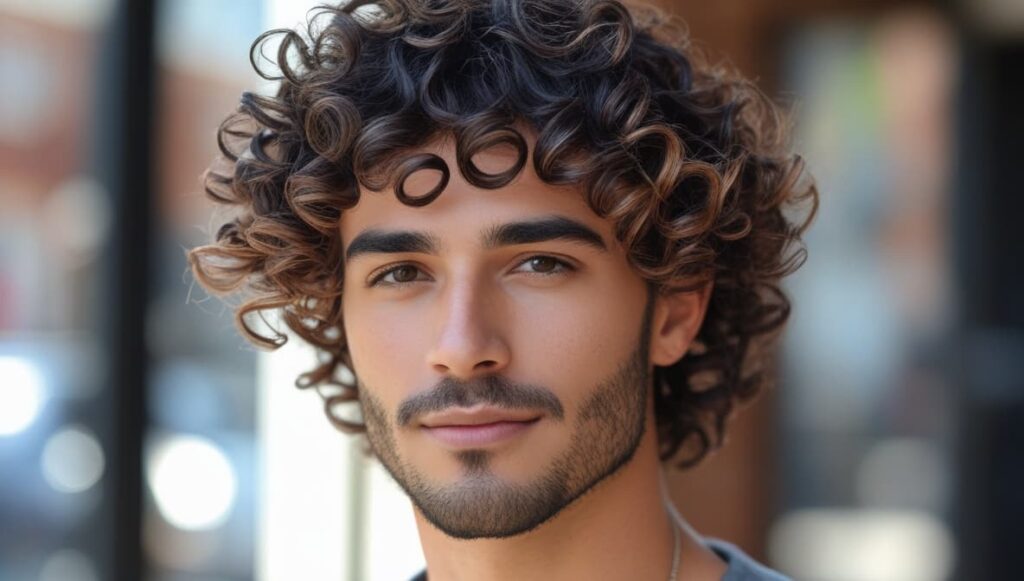
Embrace those curls! This style shapes your natural curls into a defined fringe at the front, often combined with a subtle taper on the sides. The curls are trimmed so they don’t puff up too much, and the fringe is usually kept at a length where the curls gently touch the brow.
- Best for: Naturally curly hair.
- Face shapes: Square and heart-shaped (the curls soften angles).
- Why try it? It’s all about “owning your curls”. The textured cut keeps your curls structured and defined instead of a random cloud. Use a curl cream or light mousse to finish for the best definition.
7. Textured Fringe with Undercut
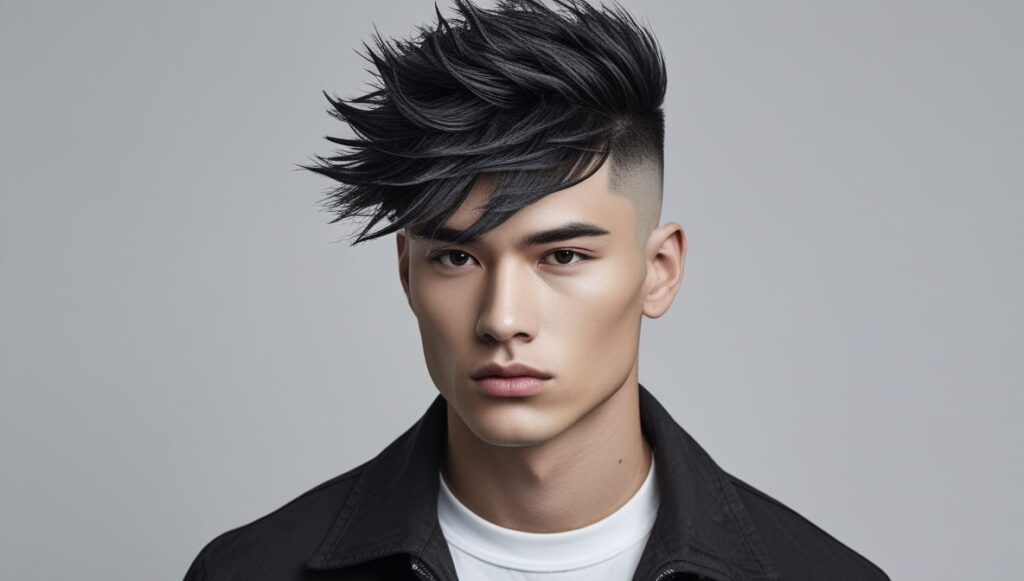
For a dramatic look. This pairs a thick, textured top (with a full fringe) against very short or shaved sides. The contrast is intense: the fringe can be messy, lifted, or even combed to the side, while the undercut is disconnected (no blending).
- Best for: Oval, round, or square faces (the undercut elongates and emphasizes features).
- Hair type: Medium to thick (so there’s enough bulk on top to style).
- Why try it? It’s eye-catching and statement-making. Perfect if you want a haircut that shouts style. Even though it’s bold, you can still wear the fringe forward for casual days or sweep it up for a night out.
FAQs
What exactly is a textured fringe haircut?
It’s essentially a fringe or bangs haircut where the front hair is cut in layers or choppy ends instead of a straight line. This creates a slightly tousled, dimensional look. Think of it as bangs with intentional “roughness” – giving depth and volume across the forehead.
Will a textured fringe suit my hair type?
Yes! Straight, wavy, and curly hair can all pull off a textured fringe. The haircut and products will differ slightly (straight hair may use sea salt spray for grip, while curly hair might use curl cream), but the style itself is adaptable. The key is to tell your barber what you want; they can adjust the layering to your natural hair movement.
Is it a high-maintenance hairstyle?
Not really – ironically, it’s known for being fairly low-effort. Once cut, most textured fringe styles are meant to look a bit undone. With the right cut and a couple of go-to products, your fringe will “hold its shape without constant restyling.” You do need regular trims to keep the shape (about every month), but day-to-day styling is usually quick.
Which face shapes suit a textured fringe best?
Actually, almost any face shape can work with the right fringe length. Oval faces are easiest – they can pull off just about any fringe. Square and heart-shaped faces often look great with a textured fringe, since the softness balances sharp angles. Round faces can also try it; just work with your barber to maybe add some height or go for a side-swept cut to elongate the face.
How do I style it at home?
Keep it simple. After washing, towel-dry your hair, then apply a bit of sea salt spray or light mousse for texture. Blow-dry your fringe forward (lifting at the roots) or slightly to the side as you like. Once dry, rub a pea-sized amount of matte wax or clay between your palms and finger-comb it through the fringe to separate the layers. For curly hair, use a curl-enhancing cream or mousse and let it dry naturally or with a diffuser. The goal is a bit of lift and definition, not a stiff freeze.
Can a textured fringe help if I have thinning hair?
Yes, it can actually add the appearance of volume at the front. By light layering and using a texturizing product, a fringe can create fullness over thinning areas. Ask your barber for a “light layering at the fringe” so it covers any thinning spots without looking sparse.
What products should I use for a textured fringe?
For hold and texture, go with sea salt sprays and matte pastes or clays. Sea salt spray (spritz on damp hair before blow-drying) gives natural lift and grip. A matte styling paste or wax (rub small amount between fingers and work through the fringe) will keep layers separated without shine. If your hair is curly or wavy, a lightweight curl cream can define strands. Just avoid heavy gels or waxes that make hair greasy or crunchy.
